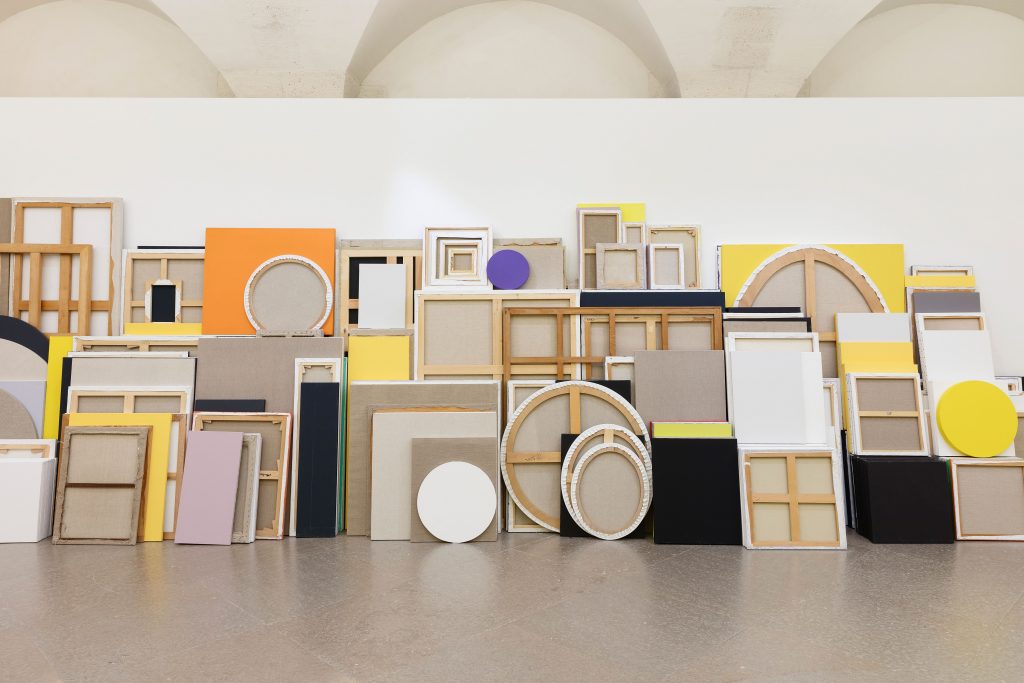
Claude Rutault (b. 1941 in Trois Moutiers, France) describes himself as a painter; and indeed, viewing one of his pieces is undoubtedly an encounter with paint on canvas. Rutault, however, does not paint his pieces himself; nor is he in the business of overseeing their production. Instead, the mainspring of his practice is the writing and issuing of a set of rules, caveats, instructions, and procedures, which he calls “de-finition/methods,” according to which a gallery, collector, or institution—known as the “charge-taker”—agrees to “actualize” a given work.
The first of these de-finition/methods, created in 1973, provided the germ for about six hundred unique works to follow. definition/method #1, “canvas per unit,” reads: “A stretched canvas painted the same color as the wall on which it’s hung. All commercially available formats can be used, be they rectangular, square, round or oval.” With this initial, relatively spare prescription, the characteristic features of Rutault’s work are evident: open-ended, ongoing, participatory, contractual, and mutually contingent with the conditions and environment in which it is to be actualized. The parameters, shape, color, and placement of the painting are constrained only by the ingenuity of its charge-taker in applying the rules established by its de-finition/method, the permutations and specific consequences of which cannot be controlled and could not have been wholly predicted by Rutault. If the charge-taker wishes to change the color of his painting, he must change the color of the wall as well. If the charge-taker wishes to repaint his wall, he must repaint the canvas to match. If he wishes to relocate the work, the wall, the painting, or both must be repainted according to the de-finition/method. Unforeseen varieties of works ensue, and report of their vagaries must be filed with Rutault—to his surprise, amusement, satisfaction, or, conceivably, displeasure. Whatever the case, he must live apart from his paintings if they are to continue living on their own; and at this juncture his role in relation to the work might be described, equally and alternately, as a referee of a game he has set into motion, as a parent watching his child sink or swim, or as a kind of cataloguer of the changes to and consequences of his own hard work.

Peter Nadin (b. 1954, Bromborough, U.K.), a key figure of the downtown art world in the late 1970s and 1980s, is a painter, sculptor and poet whose work explores the practice of mark- and image-making as fundamental, evolutionary human functions. The son of a sea captain, Nadin grew up near Liverpool in a close-knit family. He attended art school at the University of Newcastle and moved to New York City in 1976, becoming involved with a group of artists that included Jenny Holzer, Daniel Buren, Richard Prince, Sean Scully, Lawrence Weiner and Chris d’Arcangelo. In 1978, with d’Arcangelo, he founded the experimental art space 84 West Broadway. With Holzer, he published three collaborative books of poetry and images. In 1980, with Peter Fend, Colleen Fitzgibbon, Holzer, Prince and Robin Winters, he founded the collective known as The Offices of Fend, Fitzgibbon, Holzer, Nadin, Prince and Winters, which offered “practical esthetic services, adaptable to client situation,” including “suggestions for realistic action.” Nadin’s work has been included in numerous exhibitions, including ones at the Institute of Contemporary Art in Boston, the Yale Center for British Art, Brooke Alexander Gallery, Gavin Brown’s Enterprise and James Fuentes Gallery. His work is in the collection of the Metropolitan Museum of Art and was included in the 1988 Venice Biennale.
